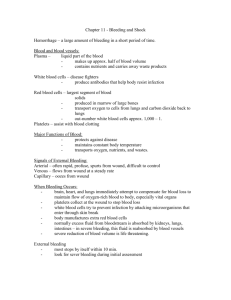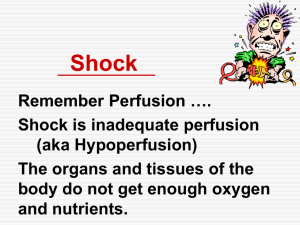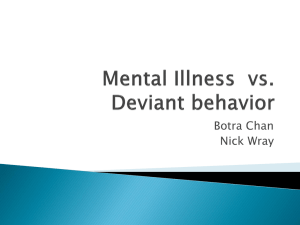Emergency obstetric care—vaginal bleeding after childbirth: Shock
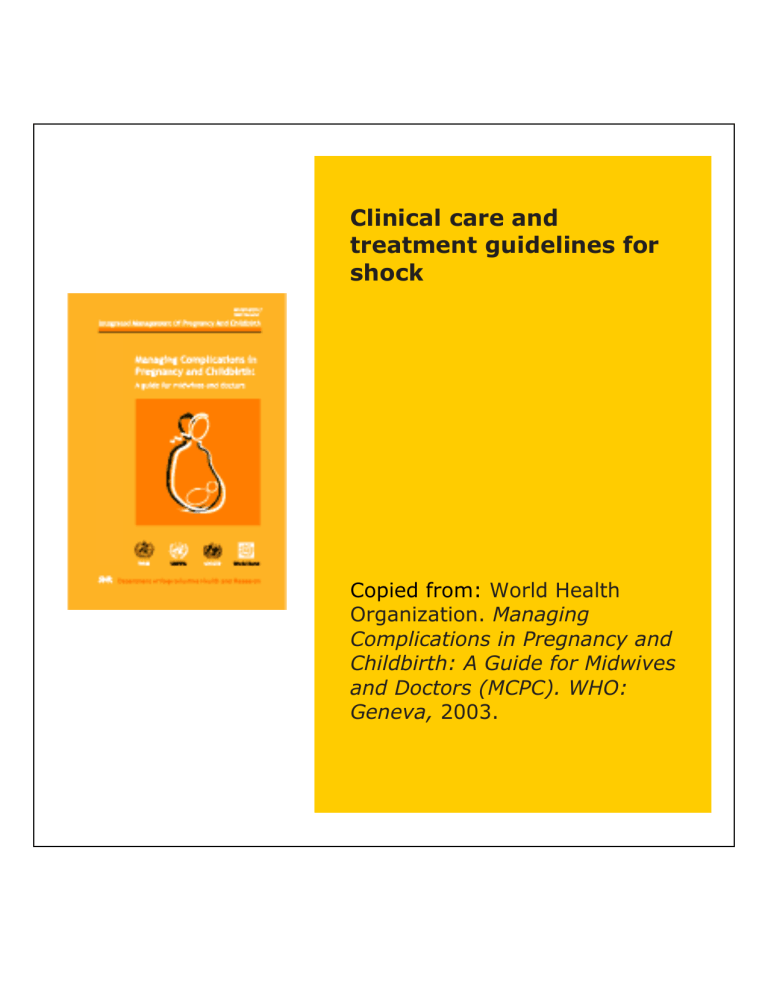
Clinical care and treatment guidelines for shock
Copied from: World Health
Organization. Managing
Complications in Pregnancy and
Childbirth: A Guide for Midwives and Doctors (MCPC). WHO:
Geneva, 2003.
Table of contents
Determining and managing the cause of shock .............................................. 5
2 Clinical care and treatment guidelines for postpartum hemorrhage
Clinical care and treatment guidelines for shock
This section includes the clinical care and treatment guidelines for shock copied from the World Health Organization manual Managing Complications in Pregnancy and
Childbirth: A Guide for Midwives and Doctors (MCPC) (2003).
http://www.who.int/reproductive-health/impac/Symptoms/Shock_S1_S5.html
(Accessed
August 11, 2008)
Shock is characterized by failure of the circulatory system to maintain adequate perfusion of the vital organs. Shock is a life-threatening condition that requires immediate and intensive treatment.
Suspect or anticipate shock if at least one of the following is present:
bleeding in early pregnancy (e.g. abortion, ectopic or molar pregnancy);
bleeding in late pregnancy or labour (e.g. placenta praevia, abruptio placentae, ruptured uterus);
bleeding after childbirth (e.g. ruptured uterus, uterine atony, tears of genital tract, retained placenta or placental fragments);
infection (e.g. unsafe or septic abortion, amnionitis, metritis, pyelonephritis);
trauma (e.g. injury to uterus or bowel during abortion, ruptured uterus, tears of genital tract).
Symptoms and signs
Diagnose shock if the following symptoms and signs are present:
fast, weak pulse (110 per minute or more);
low blood pressure (systolic less than 90 mm Hg).
Other symptoms and signs of shock include:
pallor (especially of inner eyelid, palms or around mouth);
sweatiness or cold clammy skin; rapid breathing (rate of 30 breaths per minute or more); anxiousness, confusion or unconsciousness;
scanty urine output (less than 30 mL per hour).
Management
Immediate management
SHOUT FOR HELP. Urgently mobilize all available personnel.
Monitor vital signs (pulse, blood pressure, respiration, temperature).
Turn the woman onto her side to minimize the risk of aspiration if she vomits and to ensure that an airway is open.
Clinical care and treatment guidelines for postpartum hemorrhage 3
Keep the woman warm but do not overheat her as this will increase peripheral circulation and reduce blood supply to the vital centres.
Elevate the legs to increase return of blood to the heart (if possible, raise the foot end of the bed).
Specific management
Start an IV infusion (two if possible) using a large-bore (16-gauge or largest available) cannula or needle. Collect blood for estimation of haemoglobin, immediate cross-match and bedside clotting (see below), just before infusion of fluids:
- Rapidly infuse IV fluids (normal saline or Ringer’s lactate) initially at the rate of 1 L in 15–20 minutes;
Note: Avoid using plasma substitutes (e.g. dextran). There is no evidence that plasma substitutes are superior to normal saline in the resuscitation of a shocked woman and dextran can be harmful in large doses.
- Give at least 2 L of these fluids in the first hour. This is over and above fluid replacement for ongoing losses.
Note: A more rapid rate of infusion is required in the management of shock resulting from bleeding. Aim to replace 2–3 times the estimated fluid loss.
Do not give fluids by mouth to a woman in shock.
If a peripheral vein cannot be cannulated, perform a venous cut-down (Figure
1).
Continue to monitor vital signs (every 15 minutes) and blood loss.
Catheterize the bladder and monitor fluid intake and urine output.
Give oxygen at 6–8 L per minute by mask or nasal cannulae.
Bedside clotting test
Assess clotting status using this bedside clotting test:
- Take 2 mL of venous blood into a small, dry, clean, plain glass test tube
(approximately 10 mm x 75 mm);
- Hold the tube in your closed fist to keep it warm (+ 37°C);
- After 4 minutes, tip the tube slowly to see if a clot is forming. Then tip it again every minute until the blood clots and the tube can be turned upside down;
- Failure of a clot to form after 7 minutes or a soft clot that breaks down easily suggests coagulopathy.
4 Clinical care and treatment guidelines for postpartum hemorrhage
Figure 1
Venous cut-down
Determining and managing the cause of shock
Determine the cause of shock after the woman is stabilized.
If heavy bleeding is suspected as the cause of shock:
- Take steps simultaneously to stop bleeding (e.g. oxytocics, uterine massage, bimanual compression, aortic compression, preparations for surgical intervention);
- Transfuse as soon as possible to replace blood loss;
- Determine the cause of bleeding and manage:
- If bleeding occurs during first 22 weeks of pregnancy, suspect abortion, ectopic or molar pregnancy;
- If bleeding occurs after 22 weeks or during labour but before delivery, suspect placenta praevia, abruptio placentae or ruptured uterus;
Clinical care and treatment guidelines for postpartum hemorrhage 5
- If bleeding occurs after childbirth, suspect ruptured uterus, uterine atony, tears of genital tract, retained placenta or placental fragments.
- Reassess the woman’s condition for signs of improvement.
If infection is suspected as the cause of shock:
- Collect appropriate samples (blood, urine, pus) for microbial culture before starting antibiotics, if facilities are available;
- Give the woman a combination of antibiotics to cover aerobic and anaerobic infections and continue until she is fever-free for 48 hours:
° penicillin G 2 million units OR ampicillin 2 g IV every 6 hours;
° -PLUS gentamicin 5 mg/kg body weight IV every 24 hours;
° PLUS metronidazole 500 mg IV every 8 hours.
Do not give antibiotics by mouth to a woman in shock.
- Reassess the woman’s condition for signs of improvement.
If trauma is suspected as the cause of shock, prepare for surgical intervention.
Reassessment
Reassess the woman’s response to fluids within 30 minutes to determine if her condition is improving. Signs of improvement include:
- stabilizing pulse (rate of 90 per minute or less);
- increasing blood pressure (systolic 100 mm Hg or more);
- improving mental status (less confusion or anxiety);
- increasing urine output (30 mL per hour or more).
If the woman’s condition improves:
- Adjust the rate of infusion of IV fluids to 1 L in 6 hours;
- Continue management for the underlying cause of shock.
• If the woman’s condition fails to improve or stabilize, she requires further management (see below).
Further management
Continue to infuse IV fluids, adjusting the rate of infusion to 1 L in 6 hours and maintain oxygen at 6–8 L per minute.
Closely monitor the woman’s condition.
Perform laboratory tests including hematocrit, blood grouping and Rh typing and cross-match. If facilities are available, check serum electrolytes, serum creatinine and blood pH.
6 Clinical care and treatment guidelines for postpartum hemorrhage

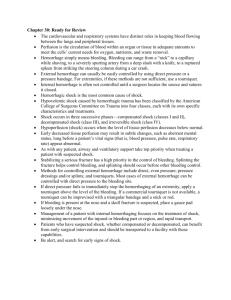

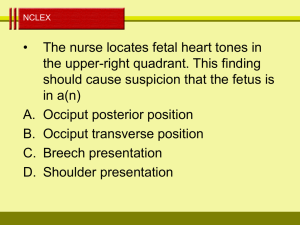
![Electrical Safety[]](http://s2.studylib.net/store/data/005402709_1-78da758a33a77d446a45dc5dd76faacd-300x300.png)


